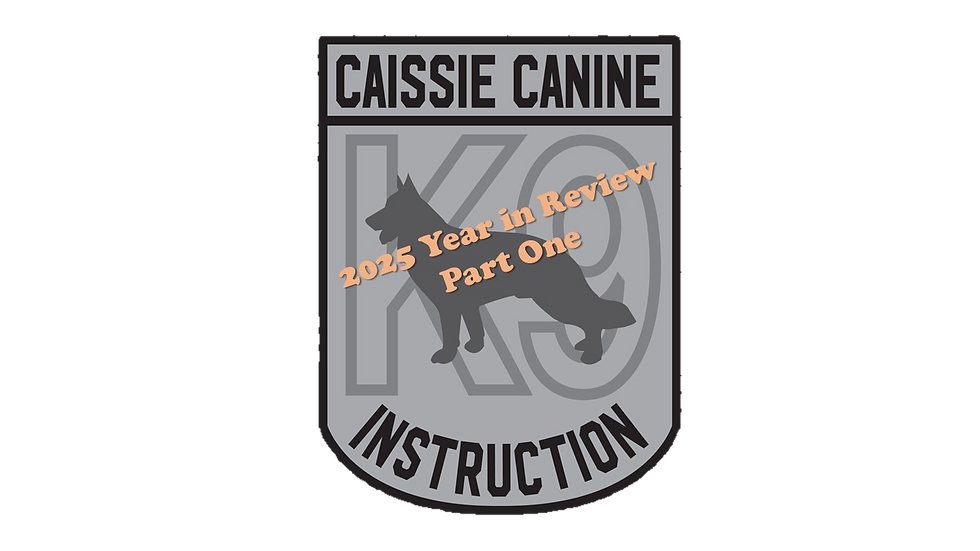Caissie Canine Instruction: Dog Park Etiquette
- caissiecanineinstr

- May 29, 2023
- 3 min read

We begin this week’s “RUFF TAILS” featuring a beautiful German Shepherd named Tracker.
Tracker had a rough start to life. He was removed from his home after neighbours had called Animal Control and local Police to notify them that a dog was being abused. When Police and Animal Control showed up, they found Tracker neglected and tied to a fence in the backyard, extremely underweight and aggressive. Tracker was sent to a rescue in Minden, Ontario called Snowflake Meadows. Once he was settled, they quickly came to see his potential and called K9ine Security Owner David Hutnyk.

Upon meeting Tracker, David knew he was a diamond in the ruff. Tracker started in the K9 program in the winter of 2021, due to his level of prey drive and aggression David knew we needed the best of the best for training. He reached out to Paul Caissie at Caissie Canine Instruction. They began training immediately, working on basic obedience, bonding, building trust and figuring out his aggression triggers.

Tracker has come a long way, to this day we are still working on socializing him with other animals. Tracker is currently fully certified in Obedience, Scent Tracking, Area Searches, and Apprehension and still trains with Paul to this day.
Tracker is currently working as a patrol dog with K9ine Security and doing presentations at school, showing off his many amazing talents. When he’s not working you can find Tracker lounging about with his Kong or out for hikes by the water with his handler.

Welcome to Doggie Dialogue
My mom and dad LOVED animals, so I grew up with dogs, cats, guinea pigs, fish, turtles, and even some friendly backyard squirrels, lol. However, back then dog parks where not available. My dad would take the dogs to an open space to run them.
Paul’s journey with dogs began throughout his Police years to include 6 Police dogs, and he too would run the dogs in open spaces, practicing retrieval work, scent detection, and tracking. Therefore, our Police dogs were not accustomed to walking in the neighbourhood or going to a dog park.
With over 25 years of owning high energy K9’s, we made the decision that our K9’s would not be the best “fit” for the dog park. We ourselves became accustomed to a routine that works best for us and our dogs.
We do understand that many people, especially living downtown Toronto, there are not many open spaces to run your dogs. With little access to open spaces for urban dwellers, the daily trip to the dog park has become a popular activity.

Most dog parks are fenced in and have a doubled-gated entry and exit points. When all participants understand and obey the park rules, the dog park can be fun and a social event for your K9.
Not all dogs are appropriate for the dog park. Puppies are a “NO” “NO”. Puppies are at risk as they are not fully immunized and are at higher risk of contracting diseases. Also, puppies can get traumatized by an older or larger dog’s inappropriate behaviour.

We recommend before venturing out to the dog park, check it out first without your dog. Look to see if the dogs are friendly, are the owner’s paying attention to their K9’s behaviour, are people respecting the rules and regulations of the dog park, and is there an area designated for small dogs and big dogs?
If you feel your K9 will be comfortable and safe at the dog park, then you will need to bring water and plenty of poop bags. Leave ALL toys at home.

We recommend using a snap collar to keep your K9 on-leash until safely in the dog park. Avoid mixing on-leash and off-leash dogs together, as the leashed dogs may become stressed and aggressive towards the off-leash dogs.
When inside the dog park, if your dog is getting overly excited, interrupt his/her play by removing them from the pack. Ask your dog to sit, then reward them with a “concealed” high value treat quickly. Once calm, then allow them back to play. Remember do NOT let the other dogs pester you for treats and do NOT feed someone else’s dog.

The dog park should be safe and fun, if your dog is misbehaving or bullying or is being bullied, leave the park.
Remember dogs chasing another dog can become predatory behaviour, this must be interrupted to give the dogs a “time out”.

Please always supervise your own dog closely to ensure that this is a positive and rewarding experience.





Comments